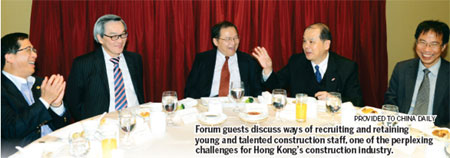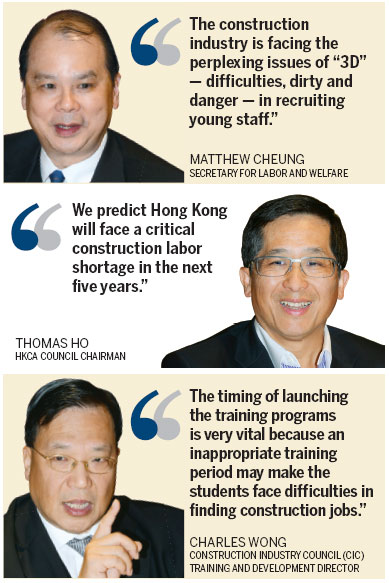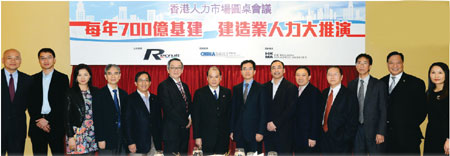Meeting challenges of HK's construction industry
Updated: 2012-12-14 07:37
By Oswald Chan(HK Edition)
|
|||||||
|
Government officials and industry players attend the roundtable co-organized by Recruit, China Daily Asia Pacific and Hong Kong Management Association, to find solutions for the challenges faced by Hong Kong's construction industry. Provided to China Daily |

The next few years will see the work peak period of most construction projects. However, the construction sector is facing problems like labor shortage and aging labor. Various solutions have been suggested, but will they work? Oswald Chan reports.
In order to tackle the pressing issues of Hong Kong's construction industry, government officials, construction company senior management, industry professional body representatives and the industry trainers have presented an integrated roadmap on how to overcome the challenges through transforming the construction industry's cultures and practices.
The SAR Media (Recruit) Roundtable, organized by Recruit Holdings and co-organized by the Hong Kong Management Association and China Daily Asia Pacific, garnered different perspectives from the industry professionals toward the issue.
According to the Construction Workers Registration Authority, there are currently 300,000 valid registered construction workers, including 40 percent workers of 50 years or more.
The Hong Kong Construction Association (HKCA) also revealed that 68 percent of the construction industry workforce is over 40 years old; 43 percent over 50 years, 10 percent over 60 years and only 13 percent of them are under the age of 30.
Most of the Roundtable speakers said that 300,000 valid registered construction workers was only just a figure; in reality the construction companies are facing hurdles in recruiting and retaining young and talented construction staff.
These predicaments include the nature of the construction work, safety, wage payment level, market competition for staff and the lack of construction subject teaching staff at local universities.
"The construction industry is facing the perplexing issues of "3D" - difficulties, dirty and danger - in recruiting young staff. The issues of "difficulty and dirty" can still be easily resolved by strengthening the industry's training qualities and enhancing the industry's professional images through the image-building process," Secretary for Labor and Welfare Matthew Cheung said.
"The issue of "danger" needs to be tackled seriously; especially since a few major industrial accidents could provoke an immediate huge drop in young staff recruitment in the construction industry," Cheung cautioned, adding that the industry must improve safety at work sites to restore confidence of new recruits and their families.
Pay rise issue
Conrad Wong, Yau Lee Holdings Vice Chairman, said the industry has to recognize the real issue of pay rise in order to attract young and talented construction workers.
"Construction workers in Europe are paid 500 euros per day which is much higher than the (pay for their) local counterparts. The young people in the city may not consider construction work as their career priority choice since the mediocre pay level cannot justify the hard work involved in the construction industry." Wong said.
"That is why it is crucial for the construction company management and the industry unions to formulate a clear roadmap on how (a worker's) salary can rise to a level that is agreeable to both parties over the next five years," he reckoned. "If a salary rise can be envisaged, this can greatly bestow a more favorable social perception toward the construction industry."
Intense competition
Besides the 3D problem and the low and unstable pay conditions, the local construction industry is also facing intense labor competition from other economies.
"Macao in recent years is accelerating various casino and hotel building projects that will attract many Hong Kong labor to work there. We predict Hong Kong will face a critical construction labor shortage in the next five years," said Thomas Ho, chief executive at Gammon Construction. Ho is also serving as the HKCA Council Chairman.
"In addition to construction worker competition, Malaysia and Singapore also compete fiercely for the skilled engineers stationed in Hong Kong. Singapore is investing SDG$20 billion on railway projects and this really posts a challenge to Hong Kong," MTR Corporation Projects Director T C Chew added.
The stable supply of construction workers and middle-level construction engineers is also hindered by the inadequate number of engineering lecturers in the local universities.
Govt funding needed
Derrick Pang, the deputy chairman at Chun Wo Development Holdings, pinpointed that the universities would not devote more resources to train more engineering lecturers just because there is a huge market demand; until the government makes special financial grants to the universities' construction departments to train more students.
"In the past, the Hong Kong Institute of Vocational Education (IVE) under the Vocational Training Council (VTC) Group, still organized some courses for training technical engineers. However, the IVE recently cut those technical engineer training courses and opened more degree courses instead, a move that will further drain the supply of qualified construction engineers," The Hong Kong Institution of Engineers President Choy Kin-kuen added.
Stephen Lai, the senior vice president at the Hong Kong Institute of Surveyors, estimated that there is a current 30 percent vacancy in the middle-rank level of qualified surveyors in the construction sector.
Soaring construction costs
The labor shortage and the aging labor issue in the construction industry are translating into soaring construction costs that might further crimp the industry's competitiveness in the future. Labor cost generally accounts for 34 percent of the total construction costs, which generally make up 30 percent of the city's total project development costs.
"This is especially evident when some construction firms are in desperate need to recruit more workers to meet the project deadlines that will drive up hiring cost significantly," said Ma Ka-chun, the training and manpower committee chairman at the Hong Kong Federation of Electrical and Mechanical Contractors.
According to the global construction consultancy firm EC Harris, Hong Kong now is being ranked as the sixth most expensive construction market in the world due to the shortage of skilled labor, rising commodity prices, increased market demand and faster inflation.
The construction industry is one of the important contributors to the local economy. According to government statistics, the value added of the construction sector, which is a measure of its contribution to Hong Kong's gross domestic product, increased to HK$65.4 billion in 2011 that jumped 16 percent over 2010. The construction activities account for 4.6 percent to the city's gross domestic product in 2011, up from the 3.3 percent in 2010.
Regarding the labor front, the construction industry in 2011 had comprised 23,400 establishments which directly hired 170,300 people.
Despite the rosy business potential, the construction industry is facing a bottleneck scenario in which the labor shortage is increasingly unable to cope with the incoming construction work peak period in the following next few years.
Ten mega projects
The 10 mega infrastructure projects announced in 2007 are gradually being rolled out in phases as scheduled. To name just a few, the MTR South Island Line and the Guangzhou-Shenzhen-Hong Kong Express Rail Link will be finished in 2015. The Tuen Mun Western Bypass and Tuen Mun Chek Lap Kok Link as well as Hong Kong-Zhuhai-Macao Bridge will be built in 2016. The Shatin to Central Link will also be finished in different phases starting from 2018 to 2020.
The participants in the Roundtable envisaged that an integrated roadmap to alleviate the labor shortage and the aging labor problem through the combination of the following factors: improving job training environment, pursuing more aggressive publicity in job fairs, the sustainability of infrastructure investment and capitalizing on the mainland-Hong Kong cooperation in the construction industry.
"The construction industry players themselves have to grasp the future labor demand projection accurately. The timing of launching the training programs is very vital because an inappropriate training period may make the students face difficulties in finding construction jobs," said Charles Wong, the Construction Industry Council (CIC) Training and Development Director. The CIC was established in 2007 to foster the strategic development of the construction industry including manpower training.
"There will be divergences between the studying environment and the actual working environment in the construction sites. We have to ensure worker training in the future should be flexible, diversified and specialized so that it can bridge the gap between the training environment and actual working environment for better labor retention," Wong added.
Mentor training system
The participants at the Roundtable agreed that the construction industry must nurture a mentor training system so that the mentors can provide practical guidance to those construction industry trainees to help them adapting to the industry requirements more quickly.
MTR's Chew added that local construction workers should be trained to be multi-skilled so that the skill transfer process can facilitate more job opportunities for the workers.
After improving the training environment, the construction companies must be aggressive enough to push more publicity work to recruit more youngsters in the job fairs held at secondary schools as soon as possible.
Corporate cultures
The Labor and Welfare Secretary Cheung stressed that the construction industry must transform its corporate cultures to become a professional industry with the distinct advantages of clear career advancement roadmap, stable income prospect and stringent industrial safety standards that can attract youngsters and persuade their parents to allow their children to join the industry.
"The local construction industry must be proactive enough to recruit sufficient young labor so that it can replenish the existing labor that will retire in the next 10 years as well as bridge the existing gap between projected labor demand and actual labor supply in the industry," Build King Holdings Chairman Derek Zen envisaged.
The Hong Kong's Construction Industry Vision 2020, advocated by the city's construction companies association HKCA in June this year, envisioned that the average workforce age should be decreased by five years of age by the year 2020, meaning that the industry has to recruit 8,000 additional new construction workers who are less than 40 years old in the next eight years.
The construction industry will strive to recruit more labors, but the industry also needs to have a clear labor projection based on the city's infrastructure investments in the next few years. That counts on the sustainability of the infrastructure investments in the years ahead.
"The construction industry is bracing for development potential in the immediate future. The government is committed to spend in infrastructure projects to spur economic growth and sustain employment level," The Labor and Welfare Secretary Cheung reiterated. "The industry will not encounter those "feast and famine" situation in the future as it did previously due to the cyclicality of infrastructure investments in the past years."
Infrastructure expansion
The Hong Kong government pledged to expand investment in infrastructure projects. The total infrastructural projects' value is expected to rise from the HK$62 billion in 2007/2008 to HK$184 billion in 2012/2013. In the next few years, the public infrastructure expenditure is estimated to exceed HK$70 billion annually.
With the greater economic integration between the mainland and Hong Kong, the city's construction sector is also poised to capitalize on the closer economic ties between both sides to promote the construction industry.
"More than 50 percent of Hong Kong developers have built their property portfolios on the mainland. Hence local construction companies need the expertise of the mainland engineering professionals. The CEPA agreement can facilitate the exchange of mainland-Hong Kong construction professionals that can fill up the engineering professional vacancy in the city," Gammon's Ho added.
Under the various supplements of the Closer Economic Partnership Arrangement between Hong Kong and the Mainland (CEPA) signed since 2003, the mainland and Hong Kong's construction engineering professionals have obtained reciprocal mutual recognition of professional qualifications that facilitates their career advancement in the two respective places.

(HK Edition 12/14/2012 page2)
